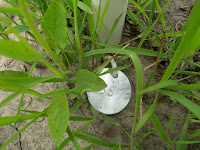This one catches many people by surprise because it really doesn’t look much like a member of the bean family (Fabaceae). In its broadest concept the bean family consists of three big subfamilies, the faboids with the typical bean flower, the mimosoids with flowers in powder puff inflorescences, and the caesalpinioids, which being largely tropical are less familiar to residents of temperate climates. And this species has none of the floral flamboyance of
Delonix regia, the royal Poinciana. Most people even fail to notice this tree is in flower, but it has the handsome broad spreading crown of its tropical relative. And several of my students correctly identified this as
Gymnocladus dioica, the Kentucky coffee tree (but they were using a plant ID manual).

 Ok, Ok, it's only thirsty, but the Phactor is being dragged across the country for the weekend, and with the formerly trusty laptop inoperative, it will be a vacation from email, blogging, and all the rest. So the only thing to do is post the Friday Fabulous Flower today. Our Missouri evening primrose began flowering yesterday, and it's among my favorite native species. They love sunny, exposed sites and deal with dry conditions quite well. It also is the largest flower in our garden, at least in length, some 25-26 cm long because of the hypanthium (The winged ovary is way on the left). Although formerly Oenothera missouriensis, it is now Oenothera macrocarpa, but that won't compute in the memory banks. Similarly students are filed in my memory by their maiden names; get married if you want, but don't expect me to remember you that way.
Ok, Ok, it's only thirsty, but the Phactor is being dragged across the country for the weekend, and with the formerly trusty laptop inoperative, it will be a vacation from email, blogging, and all the rest. So the only thing to do is post the Friday Fabulous Flower today. Our Missouri evening primrose began flowering yesterday, and it's among my favorite native species. They love sunny, exposed sites and deal with dry conditions quite well. It also is the largest flower in our garden, at least in length, some 25-26 cm long because of the hypanthium (The winged ovary is way on the left). Although formerly Oenothera missouriensis, it is now Oenothera macrocarpa, but that won't compute in the memory banks. Similarly students are filed in my memory by their maiden names; get married if you want, but don't expect me to remember you that way. 


 Give me your answer before you read on.
Give me your answer before you read on. 



